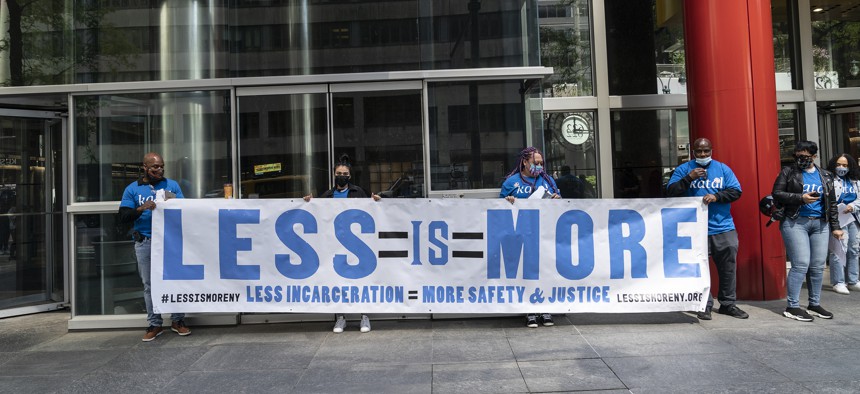Opinion
Opinion: The case for fixing probation and parole
Research shows that the supposed benefits of probation and parole are illusory, but their harms are very real.

Activists from the Katal Center rally in front of Gov. Andrew Cuomo's office on May 7, 2021 to demand he support the "Less Is More" parole reform bill. Gov. Kathy Hochul signed the bill into law on Sept. 17, 2021. Lev Radin/Pacific Press/LightRocket via Getty Images
On Sept. 17, 2021, when I was running the notorious Rikers Island jails, Gov. Kathy Hochul signed the Less Is More act into law, reducing parole revocations for non-criminal, technical violations.
When she did so, she applied the act retroactively to all people incarcerated for 30 days or more for parole violations like drug use, missed appointments and curfew violations. Unfortunately, Isaabdul Karim had only been incarcerated for 29 days, missing his release opportunity by a single day. Two days later, Mr. Karim died of COVID-19 in a Rikers Island jail.
Mr. Karim is hardly alone. In fact, the first two people to die of COVID in Rikers – Raymond Rivera and Michael Tyson – were also incarcerated for violating parole rules for missing appointments and leaving a drug program without permission.
There are nearly 4 million people under community supervision in the United States, almost twice as many as are incarcerated here. A quarter of people entering U.S. prisons are incarcerated not for committing a new crime, but for violating some condition of community supervision, at an annual cost to taxpayers of $2.8 billion.
Research now shows that the harm caused by probation and parole is very real and not outweighed by their illusory benefits. It is high time policy makers either substantially reduce the size and punitiveness of “mass supervision” or eliminate supervision programs like probation and parole entirely.
Community supervision was founded in the 1800s to divert people from prison (probation) or release them early for program participation (parole). In the 1970s, following President Richard Nixon’s declaration of a “War on Drugs” and research that erroneously concluded that “nothing works” to reduce recidivism, rehabilitation became a dirty word in criminal justice circles, supplanted by a punitive zeal. Incarceration rates mushroomed five-fold from 1972 until 2008, launching an era of mass incarceration during which U.S. imprisonment outpaced that of all other nations.
Similarly, from 1980 until 2007, the number of people on probation and parole increased nearly five-fold, launching an analogous era of “mass supervision.” Since community supervision grew alongside incarceration, it was failing in its goal of reducing imprisonment. Research conducted by my colleagues and I at the Columbia Justice Lab found that more probation and parole is associated with an increase in the number of people incarcerated and under supervision, not a decrease.
Over the past several years, there has been movement to end mass supervision. Over 100 community supervision administrators joined with prosecutors, law enforcement and formerly incarcerated people to form Executives Transforming Probation and Parole stating, “community supervision has now become overly burdensome, punitive, and a driver of mass incarceration, especially for people of color,” calling for “probation and parole to be substantially downsized, less punitive, and more hopeful, equitable and restorative.” Philanthropic organizations like Arnold Ventures and the Pew Charitable Trusts have urged the reduction of the number of people on supervision and the use of technical violations to return people to jails. And business and entertainment executives like musicians Meek Mill and Jay-Z and sports team owners Robert Kraft and Michael Rubin formed the REFORM Alliance to reduce overreliance on probation and parole.
States have likewise begun to innovate. Missouri policymakers granted people on community supervision 30 days off of supervision for every 30 days they remain violation free. As a result, 36,000 people shaved 14 months off of their supervision with no increase in recidivism. In California, a series of laws and ballot initiatives resulted in a halving of the number of people in prison and a 170,000-person reduction in community supervision. The hundreds of millions of dollars of savings paid for increased drug treatment, mental health and victims services. As imprisoned and supervised populations declined, so did crime in the Golden State.
In New York City, where I served as Commissioner of the Department of Probation from 2010 to 2014, there was a remarkable 86% decline in the number of people on probation between 2000 to 2021 and a sharp reduction in technical violations, alongside a 77% drop in the number of people in city jails. Crime consistently plummeted in New York City prior to the pandemic and has recently begun declining again. Advocacy, open-minded officials and a network of nonprofit organizations providing support to court-involved people all contributed to these positive trends.
These reforms raise an interesting question: if less supervision is good, could no supervision be even better? When Virginia abolished parole from 1995 to 1999, arrests dropped 30%. Research by the Urban Institute suggests that people released from prison without supervision do as well as people released with supervision. Our research mentioned above showed that states with more people on probation were no safer than states with fewer, and higher numbers of people on parole actually correlated with higher violent crime rates.
Probation and parole have produced disappointing outcomes for nearly two centuries with alarming racial disparities and at a high cost. My experience and decades of research suggest that limiting – or even entirely eliminating – supervision, reallocating the savings to communities and carefully studying the outcomes is justified as our country struggles with enormously high rates of imprisonment and surveillance.
Vincent Schiraldi is former Commissioner of the New York City Departments of Probation and Correction and author of the new book Mass Supervision: Probation, Parole, and the Illusion of Safety and Freedom.
NEXT STORY: Editor’s note: Penn Station redevelopment plan deserves an RFP

